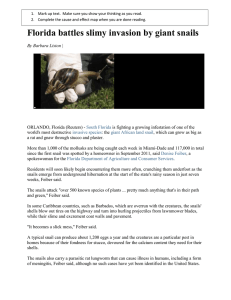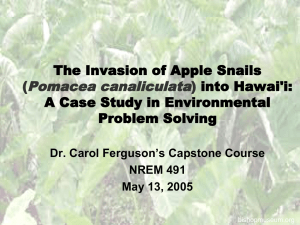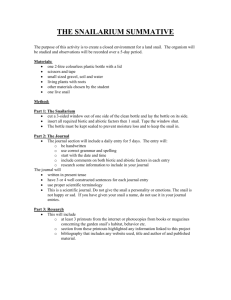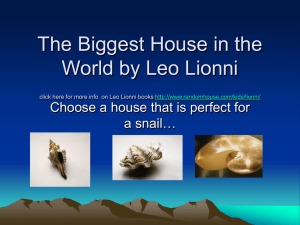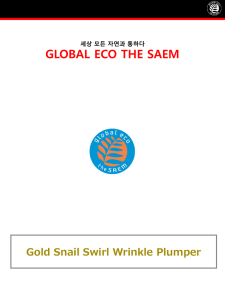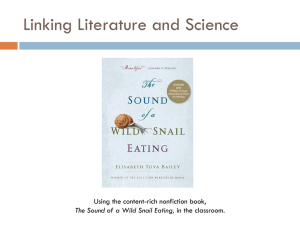Giant African Land Snail
advertisement
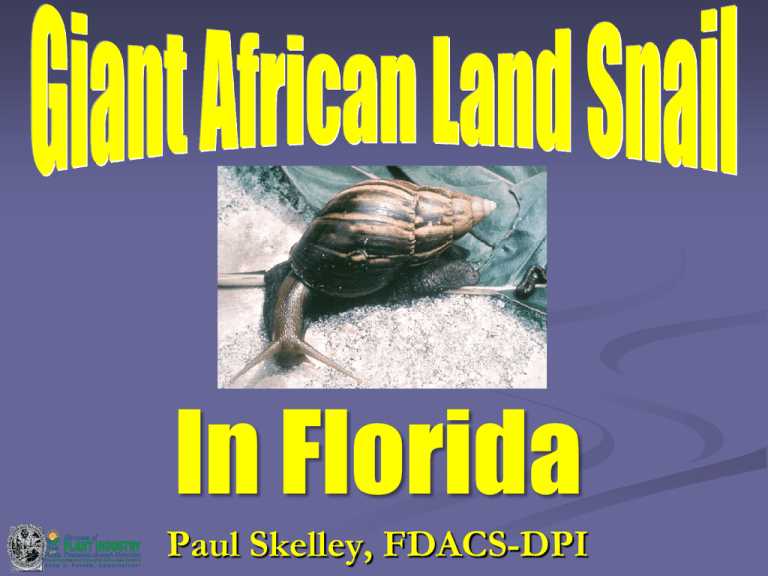
Giant African Land Snail In Florida Paul Skelley, FDACS-DPI Identification Full grown, this snail can reach up to 20 cm in length and 12 cm in diameter. Its shell is usually dark and light brown and swirls wrap around its cone like shell. Giant African Land Snail (GALS) Native to East Africa Has become a world wide pest in tropical countries, including southeastern Caribbean countries and several countries in South America. In other countries, it is a popular pet and used for educational purposes. It is also used in some religious rituals. Introductions can be intentional or accidental. Pest Status: Host Plants The Giant African Land Snail, Achatina (Lissachatina) fulica, is considered one of the most damaging snails in the world. It is known to feed on at least 500 different types of plants. Image: http://www.fao.org/forestry/30381/en/ Other Hosts In addition to fruits and plants, GALS will forage on animal matter, lichens, algae, and fungi. They have even been known to feed on stucco. Photo: FDACS/DPI Rapid Reproduction The Giant African Land Snail begins laying eggs at 5-6 months old. A single snail can produce from 300 to 1000 eggs in 3-4 batches per year. The eggs usually hatch 820 days after mating. Their lifespan lasts about 3-5 years. Photo Credit: David Robinson, USDA-APHIS-PPQ Medical Importance Public Health Concerns: Intermediate vector for: rat lungworm, Angiostrongylus cantonensis (roundworm) which causes eosinophilic meningitis in humans Aeromonas hydrophila (bacteria) Diseases (?) through their slime Establishment and Eradication in Florida In 1966, a Miami boy smuggled three Giant African Land Snails into Florida from his vacation. His grandmother released them into her garden, and in seven years, there were more than 18,000 of them. The Florida state eradication effort took years of work but GAS was eradicated in the early 1970s. Photo Credit: West Virginia Department of Agriculture http://www.wvagriculture.org/news_releases/2004/5-17-04.htm New Establishment Discovery Sept. 8, 2011 in a Coral Gables neighborhood, initiated intense survey by USDA, FDACS-DPI, and CAPS As of Sept 13, GALS was found at over 30 residences in the neighborhood, one residence having over 200 snails collected. Photo Credit: West Virginia Department of Agriculture http://www.wvagriculture.org/news_releases/2004/5-17-04.htm Present Efforts Survey work continues to delimit the population and look for others, as GALS are easily transported by human activities. Educational outreach is planned to gain more information. Eradication measures are being discussed, as allowing GAS to become fully established is not an option. Early in the Game Unlike eradicating the Mediterranean fruit fly, where we’ve had lots of practice. Eradication of this snail has many facets to consider and resolve in our present society. But we must act fast or live with the consequences. GALS compared with some native Florida tree snails. Photo credit: FDACS/DPI GALS Potential Distribution in the USA Movement on commodity Survival in transit Ability to colonize Ability to spread = probability of establishment Based on parameters: Zhou et. al. 1998 Raut & Barker 2002 Special Thanks Southern Plant Diagnostic Network (SPDN) Stephanie Stocks and Amanda Hodges, UFIFAS/SPDN Trevor Smith, FDACS/DPI
